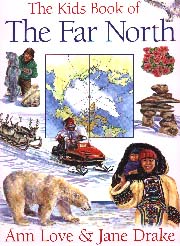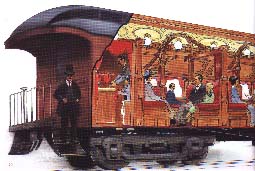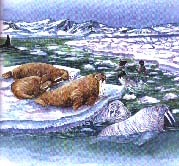|
________________
CM . . . .
Volume VII Number 15 . . . . March 30, 2001
Toronto, ON: Kids Can Press, 2000.
Grades 3 - 6 / Ages 8 - 11. **** /4
This impressive pair of books that will provide elementary-age children
with solid factual information about different subject areas. The books'
creators are to be credited not only for wanting to document events, but
also for dealing frankly with historical injustices caused by encroachment
of European civilization.
The books are organized by subject area, with indexes and tables of
contents. The layout on each page is appealing, with text interspersed by
accurate illustrations. One note of complaint: original photographs would
convey the hardships faced by the railway workers far better than an
illustration can. Similarly, people who live in the North are more
tangible to children through a photograph than a drawn illustration. The
two forms could have been combined for a more realistic and educational
presentation.
The Kids Book of Canada's Railway and How the CPR Was Built.
excerpt:
Canada was not an unpopulated territory, and the construction of the
railway was a major factor in the destruction of the Aboriginal societies
that had lived here for thousands of years. The railway brought European
settlers, destruction of the buffalo herds, and the Northwest Mounted
Police who crushed the rebellions of the Aboriginal and Metis peoples and
herded them onto inhospitable reserves. To this day, Canada's native
peoples are still experiencing the consequences of the decision to build
the railway.
Author Deborah Hodge also shows the details of trains and track construction and maintenance,
steam and diesel engines and the story of train transportation up to today. The challenges created
by a vast territory, harsh weather systems and complicated geography are discussed, along with
how engineers figured out how to deal with them and make the system run. Interesting historical
tidbits, such as school trains, relief trains and silk trains, are also mentioned.
Cities and towns came into being because of the existence of the railway. Trains carried
electioneering politicians through the land, men looking for work in the 1930's and men going to
war. Trains carried and still carry grain, raw materials and manufactured goods in massive
quantities, although they form only part of a larger transportation network today, which includes
trucks. Railway companies were political and economic forces themselves. Hundreds of thousands
of Canadians worked for the railways as they expanded their operations with the changing times.
While today the railways are not the major force they once were, they are still hauling goods and
people across the country. The role of the railway in Canada is an integral part of our history.
Accurate illustrations will keep children looking at and reading the very readable text. A glossary
of old railway terms at the end of the book will satisfy the curiosity of kids, young and old. This
book would make an excellent gift or form part of a school collection.
The Kids Book of the Far North.
excerpt:
For much of the twentieth century, the Canadian government forced Inuit children to attend
residential schools far from home. They were not at home to live and learn a hunting life from
their elders. Today, few Inuit hunt full-time, but many hunt at least part of the year.
The table of contents divides the material into easy to follow sections of two pages each. The
large-size format of the book allow for a large amount of text and illustrations on each page.
The Kids Book of the Far North would be a great read for an interested child and would
provide lots of information for a research project.
Highly Recommended.
Harriet Zaidman is a teacher-librarian in Winnipeg, MB.
To comment on this title or this review, send mail to cm@umanitoba.ca.
Copyright © the Manitoba Library Association.
Reproduction for personal use is permitted only if this copyright notice
is maintained. Any other reproduction is prohibited without
permission.
Published by
TABLE OF CONTENTS FOR THIS ISSUE - March 30, 2001.
AUTHORS |
TITLES |
MEDIA REVIEWS |
PROFILES |
BACK ISSUES |
SEARCH |
ORDER |
CMARCHIVE |
HOME
|


 The Kids Book of Canada's Railway and How the CPR Was Built is a
book for fans either of Canadian history or trains. It documents the
mammoth task of constructing a railway across an unknown and unfriendly
terrain. It talks honestly about the issues involved and the consequences
of the decisions made that still have ramifications today. The decision to
build a trans-continental railway across Canada shaped our country.
Without it, the West would likely have been annexed to the U.S. Brought
about through the grunting labour of tens of thousands of men, it was an
engineering marvel. The workers faced the gravest of hardships and the
possibility of death every day while earning a bare living and fulfilling
the dreams of the eastern politicians. Based on who the workers were,
their difficulties were compounded. Even the navvies had a class system
based on the perceptions of those days. The English-speaking workers were
given responsibilities to work with machinery, while the European workers
and the Chinese were assigned the more dangerous and unpredictable jobs.
The Chinese were charged a headtax for the right to work in Canada.
Because of their race, they were paid less, were segregated in the work
camps, and were assigned to risk avalanches and remove rock from blasting
sites. It is estimated that at least one worker died for every mile of
railway that was built. The realities of the construction are well
documented.
The Kids Book of Canada's Railway and How the CPR Was Built is a
book for fans either of Canadian history or trains. It documents the
mammoth task of constructing a railway across an unknown and unfriendly
terrain. It talks honestly about the issues involved and the consequences
of the decisions made that still have ramifications today. The decision to
build a trans-continental railway across Canada shaped our country.
Without it, the West would likely have been annexed to the U.S. Brought
about through the grunting labour of tens of thousands of men, it was an
engineering marvel. The workers faced the gravest of hardships and the
possibility of death every day while earning a bare living and fulfilling
the dreams of the eastern politicians. Based on who the workers were,
their difficulties were compounded. Even the navvies had a class system
based on the perceptions of those days. The English-speaking workers were
given responsibilities to work with machinery, while the European workers
and the Chinese were assigned the more dangerous and unpredictable jobs.
The Chinese were charged a headtax for the right to work in Canada.
Because of their race, they were paid less, were segregated in the work
camps, and were assigned to risk avalanches and remove rock from blasting
sites. It is estimated that at least one worker died for every mile of
railway that was built. The realities of the construction are well
documented.
 The Kids Book of the Far North is a wonderfully informative book about life above the tree
line. The book discusses all the important aspects of the life of the people, the animals and the
vegetation that survive in the harshest environment on the face of the planet. The climate is the
defining factor in the Far North, a region shared by Canada, the United States, Russia, Denmark,
Norway, Sweden and Finland. The different indigenous peoples who live in these countries have
adapted in different ways. The book explores their history, traditional beliefs (two folktales are
included) and methods of survival. Timelines show how human activity evolved from the time of
the Ice Age, when hunters tracked mammoths for food. The impact of European contact,
distance, pollution from the south and the pressures of the modern world are dealt with as well.
"Day-in-the-life" stories give southern children an idea of how life is for children in the Far North.
Interesting details about the physical environment give the reader a full picture of the Arctic
landscape. Fact boxes, bulleted lists and captions add to the information. The wildlife and
vegetation are richly illustrated.
The Kids Book of the Far North is a wonderfully informative book about life above the tree
line. The book discusses all the important aspects of the life of the people, the animals and the
vegetation that survive in the harshest environment on the face of the planet. The climate is the
defining factor in the Far North, a region shared by Canada, the United States, Russia, Denmark,
Norway, Sweden and Finland. The different indigenous peoples who live in these countries have
adapted in different ways. The book explores their history, traditional beliefs (two folktales are
included) and methods of survival. Timelines show how human activity evolved from the time of
the Ice Age, when hunters tracked mammoths for food. The impact of European contact,
distance, pollution from the south and the pressures of the modern world are dealt with as well.
"Day-in-the-life" stories give southern children an idea of how life is for children in the Far North.
Interesting details about the physical environment give the reader a full picture of the Arctic
landscape. Fact boxes, bulleted lists and captions add to the information. The wildlife and
vegetation are richly illustrated.